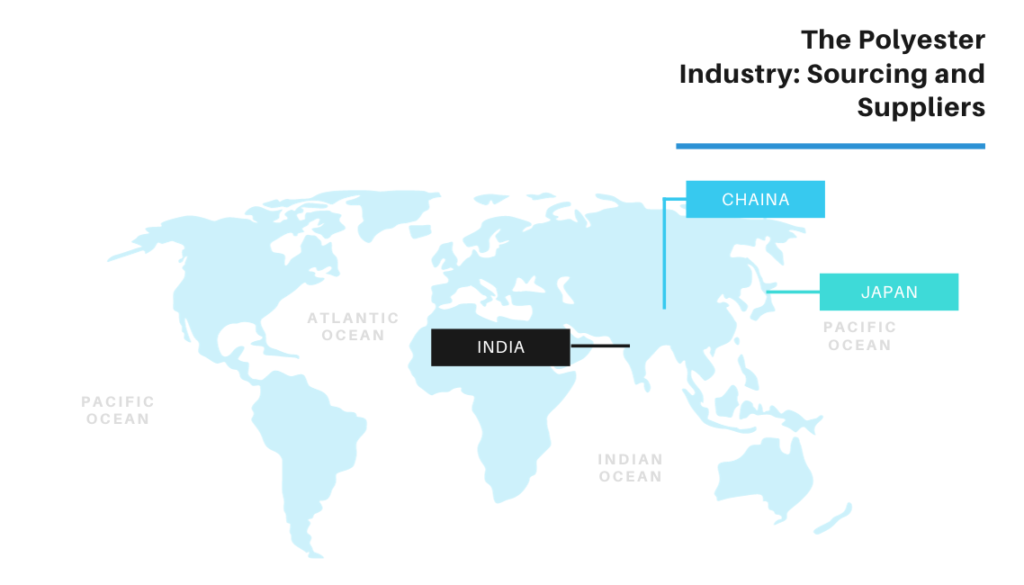Polyester Fabric
Polyester, often hailed as the fabric of the future, has woven its way into our daily lives in ways we might not even realize. From the shirts on our backs to the sheets we sleep in, it’s a material that’s both ubiquitous and versatile. In this guide, we will talk you through the most important facts about polyester, highlighting key points and offering you a glimpse into the fascinating world of this synthetic fabric.
Polyester: A Modern Marvel
Polyester, a synthetic fiber, is known for its durability and versatility. It can imitate the feel of natural fibers while offering enhanced performance. Polyester is derived from petroleum, making it a man-made product with its own unique set of characteristics.
Polyester’s history can be traced back to the mid-20th century when scientists were exploring the possibilities of creating a versatile synthetic fiber. The result was a fabric that was quick to dry, resistant to wrinkles, and easy to care for. Polyester’s durability meant it could withstand the rigors of everyday life, making it a popular choice in a wide range of applications.
The Making of Polyester
Polyester is created through a process of polymerization. In simple terms, this means that small molecules called monomers are chemically bonded together to form long chains known as polymers. The resulting long chains of polymers are then spun into fibers. The manufacturing process allows for the production of various types of polyester with differing properties, making it suitable for a wide range of applications.
Without getting too technical about the chemical process, here are the basic six steps in making of polyester:
1. Starting Ingredients: Polyester is like a recipe with two main ingredients: dicarboxylic acids and diols (glycols). Think of dicarboxylic acids as one type of ingredient, and diols as another type.
2. Mixing the Ingredients: These two ingredients are mixed together in a big pot, just like you would mix ingredients in a recipe. When you mix them, they react and create something called an “ester.”
3. Polyester Chains: This ester is the building block for polyester. It’s like playing with building blocks to make a long chain. The longer the chain, the stronger the polyester.
4. Getting Rid of Water: During this process, a bit of water is created as a by-product. It’s like when you cook and something evaporates. In this case, we don’t need the water, so we remove it.
5. Polyester Resin: What’s left after we remove the water is a substance called a “polyester resin.” It’s like a big lump of dough, but it’s made of these long chains we talked about.
6. Making Clothes: This resin can be melted and turned into threads or fibers. Those threads can then be woven into fabric. This fabric can be used to make all sorts of clothing, from shirts and pants to dresses and jackets.
So, in simple terms, polyester is made by mixing a couple of special ingredients, making a chain from them, and turning that chain into fabric. It’s like a unique recipe for making strong, colourful, and easy-to-care-for clothes for your fashion brand.
The key to polyester’s versatility lies in its ability to be engineered for specific purposes. Depending on the desired characteristics, such as moisture-wicking, breathability, or insulation, the production process can be fine-tuned to create the perfect polyester fabric for the task at hand.
Advantages of Polyester
Polyester fabric offers several advantages, making it a popular choice for a wide range of clothing and textile applications. Here are the top 10 advantages of polyester fabric:
1. Durability: Polyester is a strong and resilient synthetic fiber, making it highly durable and long-lasting. It can withstand wear and tear, making it suitable for everyday use.
2. Wrinkle Resistance: Polyester is known for its resistance to wrinkles, allowing garments made from this fabric to maintain a smooth and neat appearance.
3. Easy Care: Polyester fabrics are low-maintenance and easy to care for. They are typically machine washable and quick-drying, which makes them convenient for busy lifestyles.
4. Colourfastness: Polyester holds dye well, resulting in vibrant and long-lasting colours. It resists fading, even after multiple washes.
5. Moisture-Wicking: Polyester has moisture-wicking properties, meaning it can effectively draw moisture away from the body, keeping you dry and comfortable.
6. Stain Resistance: Polyester is less prone to stains compared to natural fibers, as it repels many common stains and is easy to clean.
7. Lightweight: Polyester fabrics are generally lightweight, which makes them comfortable to wear and suitable for travel or outdoor activities.
8. Strength: Polyester is a strong fiber that can withstand stretching, making it a suitable choice for sportswear and activewear.
9. Affordability: Polyester is often more affordable than natural fibers like cotton or silk, making it a cost-effective choice for a variety of products.
10. Versatility: Polyester can be blended with other fibers to enhance specific properties, such as adding spandex for stretch or cotton for a more natural feel. This versatility allows it to be used in a wide range of products, from clothing to upholstery and more.
While polyester fabric has its advantages, it’s important to note that it may also have some drawbacks, such as its potential for trapping heat and its environmental impact, as it is derived from petroleum-based materials. Nonetheless, its durability, ease of care, and versatility have made it a popular choice in the textile industry.
Disadvantages of Polyester
1. Lack of Breathability: Polyester is not very breathable, which means it can trap heat and moisture against the skin. This can make it uncomfortable in hot and humid conditions.
2. Heat Retention: Polyester is not a good insulator and can retain heat, making it uncomfortable to wear in very hot weather.
3. Static Electricity: Polyester can generate static electricity, leading to clinging and discomfort, especially in dry environments.
4. Pilling: Polyester fabrics are prone to pilling, which is the formation of small, unsightly balls or fuzz on the fabric’s surface, particularly in areas of friction.
5. Odor Retention: Polyester tends to retain odors, which may require frequent washing to keep garments smelling fresh.
6. Environmental Impact: Polyester is derived from petroleum, which is a non-renewable resource. The production of polyester can have negative environmental impacts due to energy consumption and emissions.
7. Microfiber Pollution: Microfiber shedding is a concern with polyester fabrics, as they release tiny plastic particles into the environment during washing, contributing to microplastic pollution in water bodies.
8. Lack of Biodegradability: Polyester is not biodegradable, and discarded polyester items can persist in landfills for extended periods.
9. Less Natural Feel: Polyester is essentially gives the feeling of – PLASTIC!
It may not have the same natural feel and texture as fabrics like cotton or silk, which some people prefer for comfort and aesthetics.
10. Potential Allergies: Some individuals may experience skin irritation or allergies when wearing polyester, although this varies from person to person.
11. Fading in Sunlight: Polyester fabrics may be prone to fading when exposed to prolonged sunlight, which can affect the vibrancy of colours. Over the prolonged period of time, polyester fabrics, particularly the ones used by the low cost fast fashion brands – those fabrics tend to fade and lose their colour vibrancy.
12. Difficulty in Dyeing: While polyester holds dye well, it can be challenging to dye once it’s already been manufactured into a fabric, limiting design options for clothing.
It’s important to consider these disadvantages alongside the advantages when deciding whether to use polyester in your clothing line, as they can impact comfort, sustainability, and the overall quality of your products.
Enjoy reading this? Subscribe below for more content like this….
Polyester in Fashion and Beyond
Polyester’s versatility has made it a staple in the fashion industry. It’s used to create a wide range of clothing, from casual wear to high-performance activewear. Its ability to mimic the qualities of natural fibers while offering superior durability has made it a favourite among designers and manufacturers.
Beyond fashion, polyester finds applications in diverse industries. Home textiles, including bed linens and curtains, often feature polyester for its easy care and durability. Automotive interiors benefit from polyester’s resistance to wear and tear, while industrial fabrics rely on its strength and resistance to environmental stressors.
Polyester’s Eco-Friendly Side
Sustainability is a growing concern in the textile industry, and polyester is adapting. Recycled polyester (rPET) is an eco-friendly option, diverting plastic waste from landfills and reducing the environmental impact. This innovative approach to polyester production transforms discarded plastic bottles into new fabric, contributing to a more sustainable future.
Polyester is also being dyed using eco-friendly techniques, reducing its impact on the environment. Traditional dyeing processes often involve a significant amount of water and chemicals, but the textile industry is exploring more sustainable alternatives. Waterless dyeing methods and the use of digital printing technologies are emerging as environmentally conscious choices.
Innovations in Polyester Technology
The future of polyester in textiles is marked by innovation. The textile industry is evolving to meet the demands of a changing world, and polyester is at the forefront of this transformation.
One exciting avenue of innovation is the development of smart textiles. Advances in technology have paved the way for fabrics with electronic components and conductive fibers. These smart textiles have applications in healthcare, sports, and fashion, offering features like temperature regulation and data collection.
Functional textiles are another area of exploration. Polyester is being engineered to possess various functionalities, including moisture management, odor control, and UV protection. These innovations enhance the performance of polyester garments in sports, outdoor activities, and everyday wear.
Digital printing on polyester fabrics is gaining popularity in the textile industry. This method offers customization, vibrant color options, and reduced water consumption compared to traditional printing methods. It’s a step toward more sustainable and efficient textile production.
The Polyester Industry: Sourcing and Suppliers
For those interested in the production and distribution of polyester, understanding the global supply chain is crucial. Sourcing reliable suppliers and manufacturers is a critical aspect of the industry.
Polyester production involves a complex network of suppliers, from the manufacturers of polymer resins to the spinners and weavers who create the fabric. The industry’s global reach means that suppliers can be located in various countries, with different stages of the supply chain contributing to the final product.
Reliable suppliers play a vital role in ensuring the quality and consistency of polyester textiles. The relationship between manufacturers and suppliers is built on trust and collaboration, which is essential for delivering high-quality products to consumers.
We are highlighting top 10 suppliers of polyester clothing from India below. Keep in mind that you should conduct your own research and due diligence when selecting suppliers for your fashion brand. Here are some prominent clothing manufacturers in India:

- Hula Global : A prominent clothing supplier mainly focussed on exports from India. Key client base includes brands from the United States and European Union for more detail contact us
- Aditya Birla Fashion & Retail Limited**: A leading fashion and retail company in India with several popular clothing brands.
- Raymond Group: Known for its quality fabric and clothing, Raymond is a prominent player in the Indian textile and apparel industry.
- Arvind Limited: A well-established textile manufacturer with a wide range of clothing products.
- Reliance Retail: Part of the Reliance Group, this company operates various fashion brands and stores.
- Lifestyle International: A fashion and retail company with a wide variety of clothing brands.
- FabIndia: Known for its ethnic and traditional clothing, FabIndia is a popular choice for Indian-inspired apparel.
- Pantaloons Fashion & Retail: A retail brand with a diverse collection of clothing options.
- Wills Lifestyle: Offers a variety of apparel for both men and women.
- Monte Carlo: Known for its winter clothing and knitwear, Monte Carlo manufactures a range of clothing items.
Please note that the landscape of clothing suppliers may change over time, and new businesses may emerge. It’s advisable to research and contact these companies directly to inquire about their product offerings, pricing, and production capabilities to determine the best fit for your fashion brand. Additionally, you can explore local garment manufacturers and suppliers in specific regions in India, as the country has a vast and diverse textile industry.
Myths:
Myth 1: Polyester is Always Uncomfortable
Fact: Polyester’s comfort depends on its specific construction. High-quality polyester garments are designed for comfort, with moisture-wicking properties that help regulate body temperature. Advances in textile technology have resulted in soft and breathable polyester fabrics suitable for various applications.
Myth 2: Polyester is Harmful to the Environment
Fact: While traditional polyester production has had environmental challenges, innovations like recycled polyester and sustainable dyeing methods are making the industry more eco-friendly. Recycled polyester, in particular, reduces plastic waste and conserves resources.
Myth 3: Polyester Doesn’t Breathe
Fact: Breathability in polyester depends on its construction. Modern polyester fabrics are engineered to provide breathability, making them suitable for activewear and outdoor clothing. The misconception about breathability may stem from older, less advanced forms of polyester.
Myth 4: Polyester is Only for Casual Wear
Fact: Polyester’s versatility allows it to be used in a wide range of applications. While it’s common in casual wear, it’s also popular in activewear, professional attire, and various technical textiles.
Wanna get in touch with us. You can also Book a 1-on-1 Call Session BOOK NOW
FAQs
Is polyester a natural or synthetic fiber?
Polyester is a synthetic fiber made from petrochemical sources. It’s created through a process of polymerization, resulting in long chains of polymers.
Is polyester fabric comfortable to wear?
Polyester’s comfort depends on its specific construction. High-quality polyester garments are designed for comfort, with moisture-wicking properties that help regulate body temperature.
Is polyester harmful to the environment?
While traditional polyester production had environmental challenges, innovations like recycled polyester and sustainable dyeing methods are making the industry more eco-friendly. Recycled polyester, in particular, reduces plastic waste and conserves resources.
Does polyester breathe?
Breathability in polyester depends on its construction. Modern polyester fabrics are engineered to provide breathability, making them suitable for activewear and outdoor clothing.
What is the Baize Fabric Guide?
Yes, polyester is commonly used in professional attire, including dress shirts, blouses, and suits. It’s favored for its durability and resistance to wrinkles.
Is recycled polyester as durable as new polyester?
Recycled polyester is just as durable as new polyester. It undergoes a process that breaks down old polyester garments into their original components, resulting in a material of the same quality.
Does polyester have UV protection?
Some polyester fabrics are designed with UV protection, making them suitable for outdoor activities and beachwear.
Can you dye polyester with natural dyes?
Polyester is typically dyed using synthetic dyes. Its resistance to moisture can make it challenging to dye with natural dyes. However, advances in dyeing methods are expanding the possibilities.
Is polyester suitable for sports and activewear?
Yes, polyester is a popular choice for sports and activewear due to its moisture-wicking properties and durability. It helps keep athletes comfortable during physical activities.
Is polyester only for clothing?
Polyester’s versatility allows it to be used in a wide range of applications beyond clothing. It’s common in home textiles, industrial fabrics, and automotive interiors.
Future of Polyester in Textiles
As we look ahead, we see a polyester industry that’s embracing sustainability, smart textiles, and functional fabrics. The future is marked by innovation, and polyester is poised to continue its reign as a versatile and reliable textile.
The textile industry is evolving to meet the demands of a changing world, and polyester is at the forefront of this transformation. From eco-friendly options like recycled polyester to the development of smart textiles, it’s clear that polyester is adapting to the ever-evolving landscape of fashion and technology.
In this guide, we’ve scratched the surface of the rich world of polyester. The comprehensive e-book delves deeper into each topic, offering a wealth of knowledge and insight. If you’re interested in learning more, exploring references, or diving into specific areas of polyester, our e-book is the perfect resource to continue your journey.
Whether you’re a textile enthusiast, a student of fashion, or simply someone curious about the fabrics that surround you, polyester’s story is one that’s worth exploring.
Read also

